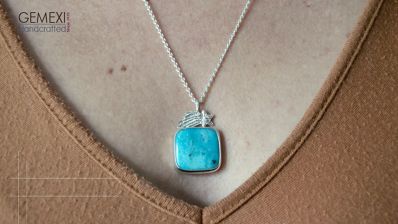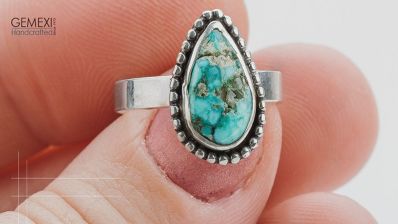Native American Jewelry Style Guide: Exploring Zuni, Navajo, and Hopi Jewelry
By Gemexi Team | Turquoise- Updated On Jul 21, 2023

Native American jewelry is a cherished art form that represents the rich cultural heritage of Indigenous tribes in the United States. Each tribe has its distinctive style, techniques, and symbolism, contributing to the diversity and beauty of Native American jewelry. In this style guide, we will explore the jewelry traditions of three prominent tribes: Zuni, Navajo, and Hopi. We will delve into their unique patterns, designs, and materials used, offering a deeper understanding of their craftsmanship and cultural significance.
I. Zuni Jewelry: Intricate Stone Inlay and Needlepoint Designs
- 1. Stone Inlay:
Zuni jewelry is renowned for its intricate stone inlay work. Zuni artisans meticulously cut and fit small pieces of gemstones, such as turquoise, coral, jet, and shell, into intricate patterns on silver settings. The stones are often cut into precise shapes, creating geometric patterns or pictorial representations. The stone inlay technique is used in various jewelry pieces, including rings, pendants, bracelets, and earrings.
- 2. Needlepoint:
Needlepoint is a specific style of Zuni jewelry that involves setting long, narrow stones in a row to create a delicate and elegant design. The stones are often turquoise or coral and are individually shaped and set in silver bezels. The resulting patterns resemble the needlework of a fine embroidery, hence the name "needlepoint." Needlepoint designs are commonly seen in earrings, pendants, and bracelets.
- 3. Stones Used:
The Zuni people are known for using a wide range of stones in their jewelry. Some of the commonly used stones include turquoise, coral, jet, mother of pearl, shell, and various colorful gemstones. Each stone holds its own significance and is carefully selected to complement the overall design.
II. Navajo Jewelry: Silverwork and Turquoise Embellishments
- 1. Silverwork:
Navajo jewelry is known for its exquisite silverwork, characterized by intricate stamping, hand-stamped designs, and repoussé techniques. Navajo silversmiths skillfully manipulate silver to create elaborate patterns, such as geometric shapes, feathers, and flora. The silverwork serves as the foundation for many Navajo jewelry pieces, including cuffs, rings, pendants, and earrings.
- 2. Turquoise Embellishments:
Turquoise holds significant cultural and spiritual importance in Navajo traditions. Navajo jewelry often features vibrant turquoise stones, both in their natural form and as cabochons, set in silver settings. The use of turquoise enhances the beauty and symbolism of the jewelry, as turquoise is believed to bring protection, good fortune, and healing. Necklaces, bracelets, rings, and earrings showcase the Navajo craftsmanship and the allure of turquoise.
- 3. Stones Used:
Turquoise is the most commonly associated stone with Navajo jewelry, symbolizing protection and healing. Additionally, the Navajo people use a wide range of gemstones, including coral, spiny oyster shell, lapis lazuli, and various colorful semi-precious stones, to add vibrancy and visual interest to their pieces.
III. Hopi Jewelry: Symbolism and Overlay Technique
- 1. Symbolism:
Hopi jewelry is renowned for its symbolic motifs, which reflect the spiritual beliefs and ancestral traditions of the Hopi people. Common symbols include the Water Wave, Raincloud, Kokopelli, and Cornstalk. These symbols represent vital elements in Hopi culture, such as water, fertility, and prosperity. Hopi artisans skillfully incorporate these symbols into their jewelry designs, creating pieces that embody cultural identity and sacred meaning.
- 2. Overlay Technique:
Hopi jewelry is distinguished by its unique overlay technique. This technique involves layering two sheets of silver, with the top layer intricately cut and textured to reveal the design against a darker background. The designs often feature symbolic patterns and motifs. Hopi jewelry pieces, such as cuffs, pendants, and rings, showcase the mastery of this technique, with its distinct contrast and striking visual impact.
- 3. Stones Used:
While silver is the primary focus of Hopi jewelry, the tribe also incorporates stones such as turquoise, coral, and opal as accent pieces. The stones are often set into the silverwork, enhancing the overall design and symbolism of the piece.
IV. Materials Used in Native American Jewelry:
- 1. Turquoise:
Turquoise is the most iconic gemstone used in Native American jewelry. Its vibrant blue and green hues symbolize protection, healing, and good fortune. Turquoise is often sourced from mines in the Southwest, including the famous Sleeping Beauty, Kingman, and Royston mines.
- 2. Coral:
Coral is another significant material used in Native American jewelry, particularly in Zuni and Navajo designs. The vibrant red and orange coral represents life force and vitality. Mediterranean and branch coral are commonly used, adding a splash of color and texture to various jewelry pieces.
- 3. Shell:
Shell, such as mother-of-pearl, abalone, and spiny oyster, holds cultural and spiritual significance in Native American traditions. These shells are carefully carved and shaped to create beautiful inlay work, adding iridescence and natural elegance to jewelry designs.
- 4. Other Gemstones:
In addition to the stones mentioned above, Native American jewelry incorporates various gemstones such as lapis lazuli, malachite, onyx, amethyst, and many more. These gemstones are chosen for their unique colors, patterns, and energies, adding depth and individuality to the jewelry.
Native American jewelry from the Zuni, Navajo, and Hopi tribes is a testament to the creativity, skill, and cultural heritage of the Indigenous people. Zuni artisans excel in stone inlay and needlepoint designs, while Navajo silversmiths master the art of silverwork and turquoise embellishments. Hopi jewelers showcase their symbolism-rich designs through the unique overlay technique. The use of materials like turquoise, coral, shell, and silver enhances the beauty and cultural significance of these jewelry pieces. Whether you choose a Zuni inlay pendant, a Navajo turquoise cuff, or a Hopi overlay ring, each piece represents a profound connection to the Native American traditions and the timeless allure of Southwest jewelry.
Native American jewelry from the Zuni, Navajo, and Hopi tribes is a testament to the creativity, skill, and cultural heritage of the Indigenous people. Zuni artisans excel in stone inlay and needlepoint designs, while Navajo silversmiths master the art of silverwork and turquoise embellishments. Hopi jewelers showcase their symbolism-rich designs through the unique overlay technique. The use of materials like turquoise, coral, shell, and silver enhances the beauty and cultural significance of these jewelry pieces. Whether you choose a Zuni inlay pendant, a Navajo turquoise cuff, or a Hopi overlay ring, each piece represents a profound connection to the Native American traditions and the timeless allure of Southwest jewelry.
- Tags:
- Native American Jewelry
- Turquoise
- Coral
- Stone Inlay
- Native American Style Jewelry
- Silverwork
- Shell










0 Comments
Write Comments